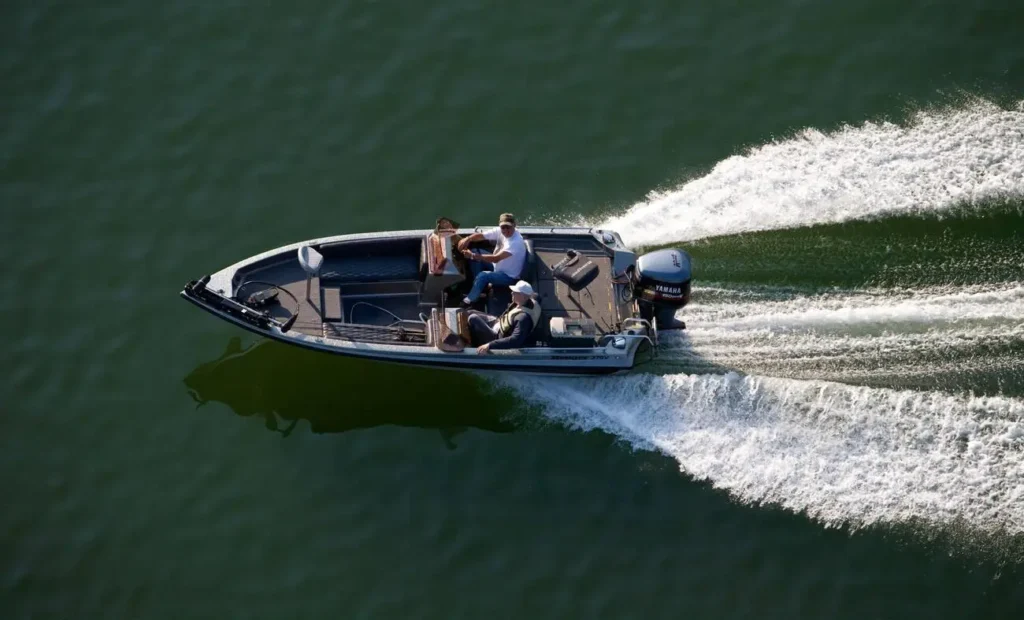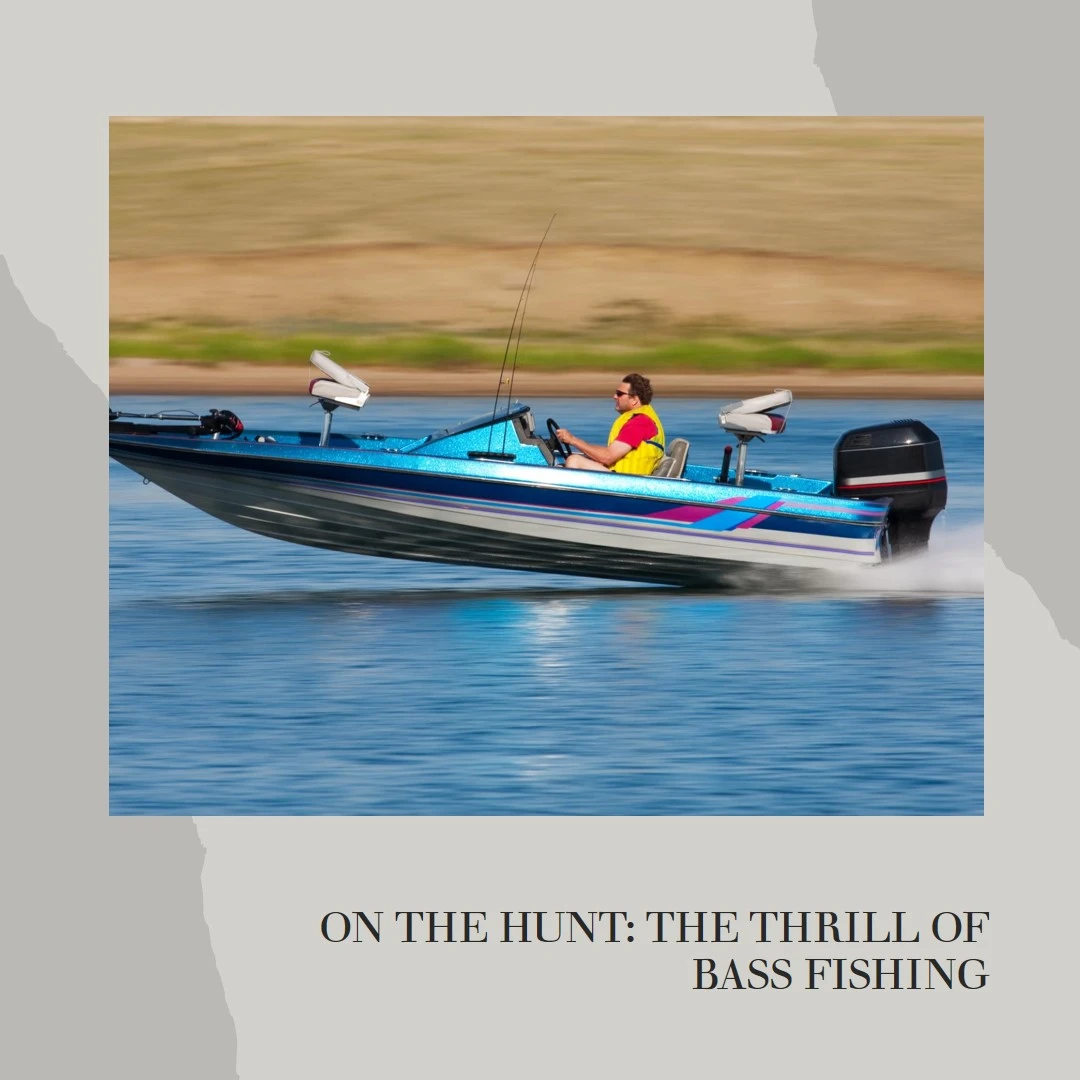To get a bass boat on plane, increase the throttle gradually while maintaining a level trim. Getting a bass boat on plane requires a careful sequence of actions to achieve optimum speed and efficiency.

This article will guide you through the process of getting your bass boat on plane, allowing you to cruise smoothly on the water and improve your fishing experience.
Whether you’re a seasoned boater or a newbie to the sport, understanding the key steps to getting on plane will ensure a safe and enjoyable ride.
So, let’s dive in and explore how to get a bass boat on plane effectively.
Table of Contents
What does it mean to get a boat on plane?
When a boat is said to be “on plane,” it means that it is moving fast enough that the bow (front part of the boat) is up and the boat is riding on top of the water rather than pushing through it.
Here’s a bit more detail:
- Displacement Mode: When a boat is moving slowly, it is in displacement mode. It’s pushing water aside and creating a wake. The boat is essentially plowing through the water, and it is quite inefficient.
- Pre-Planing: As the boat speeds up, the bow will rise, creating a larger wake and burning more fuel. This is a transitional phase between displacement mode and planing.
- Planing: When the boat reaches a certain speed (different for each boat), the bow will drop back down, and the boat will ride more on the surface of the water than in it. This is called planing. When on plane, a boat is at its most efficient, moving quickly with less drag and using less fuel.
So, when we talk about getting a boat on plane, we’re talking about accelerating the boat to the point where it is riding on top of the water, leading to better speed and efficiency.
How to get a boat on plane with trim tabs?
Trim tabs are small surfaces attached to the trailing edge of a larger parent surface on a boat, usually at the stern (rear).
They can be adjusted up or down to create upward or downward force, which can help the boat to get on plane more quickly and stay on plane at lower speeds.

Here’s how you can use them:
- Safety Measures: Before you set out on any voyage, confirm that all safety protocols are adhered to. This includes verifying that all individuals aboard are wearing life vests, all equipment is properly stowed and secured, and the conditions are suitable for boating.
- Preparation: Begin with your trim tabs in the fully lowered position. This initial setup will exert upward pressure on the stern, pushing the bow downward and consequently reducing the hull’s resistance to planing.
- Progressive Power Application: Start accelerating slowly and steadily. As you do so, you’ll observe the bow beginning to rise as the stern sinks slightly due to increased thrust.
- Trim Tab Adjustment: Now, you need to counterbalance the bow rise with trim tab adjustment. Start to raise the trim tabs incrementally. This reduces their lift, allowing the bow to lower and the stern to rise. This adjustment creates an aerodynamic balance that helps your boat achieve a planing state more efficiently.
- Achieving Plane: Continue with the steady acceleration. The moment when the boat transitions from displacing water to gliding over it signifies that you’re on plane. You should notice a definitive reduction in resistance and a smooth, rapid ride.
- Optimizing the Ride: Once planing, adjust your trim tabs for the optimal ride. Given that the weight distribution and sea conditions influence your boat’s balance, tweak the trim tabs to ensure that the boat remains level and doesn’t list to either side.
- Engine Trim: After reaching a planing state, if your vessel is equipped with an outboard motor or a sterndrive, you may need to adjust the engine trim. Trimming out, or tilting the engine up slightly, can further enhance the boat’s running angle, providing a more efficient, faster, and smoother ride.
- Speed Maintenance: Uphold a constant speed to stay on plane. If the speed falls too much, your boat will transition back to a displacement mode, necessitating a repetition of the process to regain the planing state.
Pro tip: While efficiency and speed are desirable, nothing beats safety when it comes to watercraft operation. Always adhere to local boating laws and ensure you and your passengers are safe during your boating adventures.
You may also like to know:
- Where to Mount Transducer on Bass Boat? (How to insatll?)
- How Much is Bass Boat Insurance cost in 2023?
- How to Drive a Bass Boat? [Ultimate Guide]
- How Much Does a Bass Boat Weigh With Trailer?
- How Shallow Can a Bass Boat Go [Good or Bad?]
Finding The Optimal Trim Angle
The process of finding your boat’s optimal trim angle is a dynamic task that involves a delicate balance of factors, primarily speed, engine efficiency, fuel economy, and comfort. To begin, always start with your boat level and the trim fully down. Next, you should gradually accelerate to your cruising speed.
Once you’ve achieved a planing state, slowly begin to trim up. This adjustment lifts the bow, reduces water resistance, and can lead to increased speed and improved fuel efficiency. Importantly, monitor your speedometer, tachometer, and fuel gauge throughout this process. Your goal is to increase speed and maintain or reduce RPMs while improving fuel efficiency. If these metrics plateau or degrade, you’ve likely overshot the optimal trim angle.
While performance parameters are essential, never overlook the comfort and safety aspects of your ride. If you experience a bumpy ride or compromised visibility due to the raised bow, you’ll need to trim down until the ride smoothens and your field of vision improves.
The trim angle that delivers the best blend of speed, engine performance, fuel efficiency, and comfort is your optimal trim angle. However, remember that this may change with factors like load distribution, water conditions, and wind.
Hence, always be prepared to make necessary adjustments for the best possible boating experience. Understanding your boat’s response to trim adjustments is an art, one that improves with practice.
FAQs Of How To Get A Bass Boat On Plane:
How Can I Get My Bass Boat On Plane Quickly?
To get your bass boat on plane quickly, ensure that your boat is properly trimmed by adjusting the engine tilt and trim. Distribute weight evenly to optimize balance. Apply steady throttle and trim up gradually until the boat rises to a plane.
Avoid sudden movements to maintain stability.
What Is The Best Technique For Getting A Bass Boat On Plane?
The best technique for getting a bass boat on plane is to start with the proper trim and weight distribution. Slowly apply throttle while keeping the bow down, gradually adding speed. Focus on maintaining a steady hand on the throttle and making small adjustments to trim as needed to reach and maintain a plane.
How Should I Adjust The Trim Of My Bass Boat?
To adjust the trim of your bass boat, use the tilt and trim feature on your engine. Experiment with raising and lowering the engine until you find the sweet spot where the boat is balanced and the bow stays down.
Adjust the trim as needed throughout your boating experience to account for changes in weight and conditions.
Conclusion
Getting a bass boat on plane is an essential skill for any angler looking to maximize their fishing experience. By following the steps outlined in this blog post, you can ensure a smooth transition from idling to planing, allowing your boat to glide effortlessly through the water.
Remember to start with proper weight distribution, gradually increase throttle, and utilize trim tabs to achieve the desired planing angle. Keep in mind that practice makes perfect, so don’t get discouraged if it takes a few tries to find the right balance.
